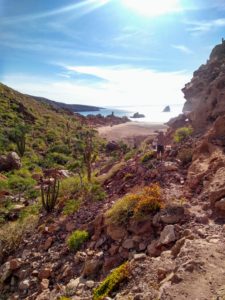 The imposing, bird-covered Monument rock at Ensenada El Candelero on Isla Espíritu Santo is surrounded by fish, crabs, and red seastars clinging to the rocks. After a drift around in the dinghy watching all the life thriving in the shallow water, we headed to the beach to follow a trail to a dried-up waterfall. The island is managed by CONANP (National Commission of Natural Protected Areas) and has six authorized paths for hiking, accessible from different bays. This was one of the easy ones, a 40 minute round trip according to the leaflet we were given when we bought our permit to enter National Parks on our boat, and suitable, we hoped, for a young sailor to work his land-legs.
The imposing, bird-covered Monument rock at Ensenada El Candelero on Isla Espíritu Santo is surrounded by fish, crabs, and red seastars clinging to the rocks. After a drift around in the dinghy watching all the life thriving in the shallow water, we headed to the beach to follow a trail to a dried-up waterfall. The island is managed by CONANP (National Commission of Natural Protected Areas) and has six authorized paths for hiking, accessible from different bays. This was one of the easy ones, a 40 minute round trip according to the leaflet we were given when we bought our permit to enter National Parks on our boat, and suitable, we hoped, for a young sailor to work his land-legs.
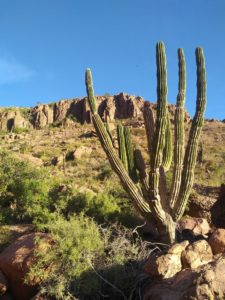 The muddy river bed between the beach and the gorge was home to a million crabs, the kind with one over-developed arm. Fiddler crabs, I think, is the generic term and appropriate for their scuttling dance. Then there was a throne-shaped orange boulder to sit on. Unsurprisingly, we spent the twenty minutes predicted walking time just on our approach to the official starting point! After crossing the flats, a cactus-lined route took us up into the orange rocks of the little canyon, towards a well.
The muddy river bed between the beach and the gorge was home to a million crabs, the kind with one over-developed arm. Fiddler crabs, I think, is the generic term and appropriate for their scuttling dance. Then there was a throne-shaped orange boulder to sit on. Unsurprisingly, we spent the twenty minutes predicted walking time just on our approach to the official starting point! After crossing the flats, a cactus-lined route took us up into the orange rocks of the little canyon, towards a well.
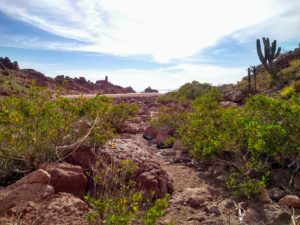 Next to the square-walled well, a plastic bucket hung on a tree branch, tied to a long knotted rope. The same site, pre-well, was a source of water for the indigenous Pericú who lived on these islands, then later for the Spanish settlers and Jesuits who founded the Missions in this area. Fishermen and a military troop have used it in more recent times. Now it’s recommended that you don’t drink from it, although as we approached a guy bounded past us, carrying a full bucket as he climbed over the rocks to a camp set up on the beach. We had a quick lesson about wells and another necessarily speedy one about the importance of not leaning too far over the edge, and tried out our bucket lifting skills.
Next to the square-walled well, a plastic bucket hung on a tree branch, tied to a long knotted rope. The same site, pre-well, was a source of water for the indigenous Pericú who lived on these islands, then later for the Spanish settlers and Jesuits who founded the Missions in this area. Fishermen and a military troop have used it in more recent times. Now it’s recommended that you don’t drink from it, although as we approached a guy bounded past us, carrying a full bucket as he climbed over the rocks to a camp set up on the beach. We had a quick lesson about wells and another necessarily speedy one about the importance of not leaning too far over the edge, and tried out our bucket lifting skills.
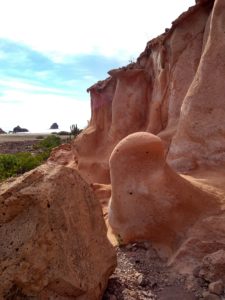 We don’t have a water maker on board, but we do have a filter and bleach, so we treat water with that when we get it from places we’re not too sure about. On a boat, water, like power, can be a constant preoccupation. We can carry 220 gallons in our water tank, plus some emergency spare containers, and as long as we don’t spring a leak we’re not normally worried about running out, but we do start to ration a bit when we’re away from the dock for too long. At Christmas, when we changed our plan and didn’t move quickly south as we’d thought we would, lack of water was definitely on our minds. We rationed toilet flushes, showers, and dish-washing water use (yup, it’s a glamorous life), knowing we hadn’t filled up the tank since we´d arrived in Mexico, having only added a few gallons in Ensenada. Our friends on S/V Goblin, who do have a water maker that needs to run regularly, gave us 25 gallons so we didn’t need to start rationing too strictly – thanks Goblins!
We don’t have a water maker on board, but we do have a filter and bleach, so we treat water with that when we get it from places we’re not too sure about. On a boat, water, like power, can be a constant preoccupation. We can carry 220 gallons in our water tank, plus some emergency spare containers, and as long as we don’t spring a leak we’re not normally worried about running out, but we do start to ration a bit when we’re away from the dock for too long. At Christmas, when we changed our plan and didn’t move quickly south as we’d thought we would, lack of water was definitely on our minds. We rationed toilet flushes, showers, and dish-washing water use (yup, it’s a glamorous life), knowing we hadn’t filled up the tank since we´d arrived in Mexico, having only added a few gallons in Ensenada. Our friends on S/V Goblin, who do have a water maker that needs to run regularly, gave us 25 gallons so we didn’t need to start rationing too strictly – thanks Goblins!
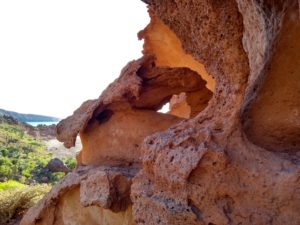 Generally we fill up at every opportunity, but we’ve got used to minimizing our use just in case, and since we´ve been on the Baja Peninsula we´re very aware that water availability is a little different to the usual abundance in Vancouver. It´s desert-like and dry through much of the area. Resorts, golf courses and the tourist industry in general require huge amounts of water and we try to be as mindful as possible of our consumption. While we were in La Paz there were protests about a proposed US-owned brewery in Mexicali (producers of Corona, Modelo, and Pacífico), planned to cater to beer-drinking visitors and threatening availability of already scarce water supplies for local people. Similar issues are a reason for local resistance to plans for an open pit gold mine in the region during the last few years. Water at the marinas is metered and often not suitable for drinking. In lots of the villages, houses have water butts to collect any rainfall, but the rain we had recently at Balandra beach was the first proper rain we´d seen in months, so at this time of year they probably don´t catch a whole lot.
Generally we fill up at every opportunity, but we’ve got used to minimizing our use just in case, and since we´ve been on the Baja Peninsula we´re very aware that water availability is a little different to the usual abundance in Vancouver. It´s desert-like and dry through much of the area. Resorts, golf courses and the tourist industry in general require huge amounts of water and we try to be as mindful as possible of our consumption. While we were in La Paz there were protests about a proposed US-owned brewery in Mexicali (producers of Corona, Modelo, and Pacífico), planned to cater to beer-drinking visitors and threatening availability of already scarce water supplies for local people. Similar issues are a reason for local resistance to plans for an open pit gold mine in the region during the last few years. Water at the marinas is metered and often not suitable for drinking. In lots of the villages, houses have water butts to collect any rainfall, but the rain we had recently at Balandra beach was the first proper rain we´d seen in months, so at this time of year they probably don´t catch a whole lot.
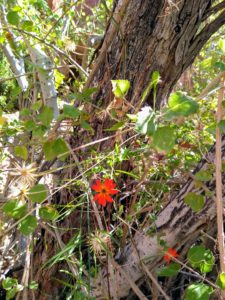 So it was tempting to fill our bottles from the well, but it definitely didn’t look entirely clean; we tipped the bucket back in and carried on, ready to see what kind of plants grow here. We’ve been getting used to the bare, rocky landscape, and as it´s got more familiar, it´s seemed more and more beautiful, but everywhere we’ve gone I’ve been amazed by how much life there is when you start to look more closely. From a distance the hill sides look empty of anything but rocks, but as soon as you start walking down some stony path, you find yourself surrounded by different shades of green. Cactus, of course, but lots of other plant life too, some of it bright with flowers.
So it was tempting to fill our bottles from the well, but it definitely didn’t look entirely clean; we tipped the bucket back in and carried on, ready to see what kind of plants grow here. We’ve been getting used to the bare, rocky landscape, and as it´s got more familiar, it´s seemed more and more beautiful, but everywhere we’ve gone I’ve been amazed by how much life there is when you start to look more closely. From a distance the hill sides look empty of anything but rocks, but as soon as you start walking down some stony path, you find yourself surrounded by different shades of green. Cactus, of course, but lots of other plant life too, some of it bright with flowers.
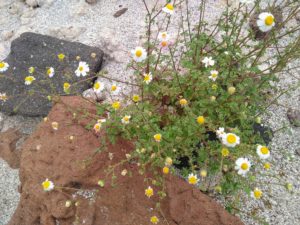 And this walk was like a whole other world as we got deeper into the rocky river’s path. Although it´s totally dried up on the surface, there must be water not far below the surface sustaining all this life and there were even signs telling us the names of things: Pitahaya Agria (Stenocereus gummosus), an endemic cactus, Copal Colorado or elephant tree, Matacora (Jatropha cuneata) also known, I think, as Limberbush, Cyrtocarpa edulis, a type of tree in the subfamily Spondiaddoidae of the cashew and sumac family, and even fig trees, pollinated by wasps. There were daisies poking out of the gravelly floor and blue and red blossoms peeping through rocks. Everything smelt amazing in the hot sun.
And this walk was like a whole other world as we got deeper into the rocky river’s path. Although it´s totally dried up on the surface, there must be water not far below the surface sustaining all this life and there were even signs telling us the names of things: Pitahaya Agria (Stenocereus gummosus), an endemic cactus, Copal Colorado or elephant tree, Matacora (Jatropha cuneata) also known, I think, as Limberbush, Cyrtocarpa edulis, a type of tree in the subfamily Spondiaddoidae of the cashew and sumac family, and even fig trees, pollinated by wasps. There were daisies poking out of the gravelly floor and blue and red blossoms peeping through rocks. Everything smelt amazing in the hot sun.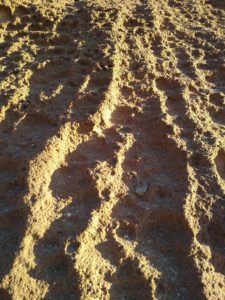
All up the river we´d been marveling at the strange formations in this ignimbrite rock – the holes and hollows, called tafoni, have been shaped over the years by the moisture of the salty sea winds.The track went up alongside the beautiful orange stone to dramatic caves and cliffs, molded over time by flowing water, but now dry and dusty and perfect for scrambling around. Lizards, alert to every footstep, stretched out on them, and yellow butterflies snuck in and out between branches and leaves.
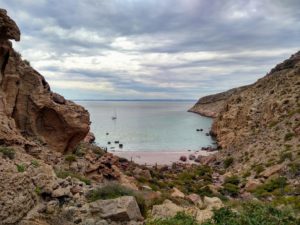 It´s always amazing, after days at sea level, to get some height and perspective. We watched the light changing on the distant water and mountains as sunset approached, and when we looked down into the bay, we saw our friends on SV Decision had already anchored, just in time for a shared dinner and conversation (the grownups) and lego and craziness (the kids). I was still thinking about the spectacular walk to the dried waterfall and the well a few days later, after a rolly sail a bit further north, accompanied by whales, to beautiful Isla San Francisco – how water is such a focus when you either have too much or not enough, and how the needs of local people and the land are ignored in favour of profit and business developments. Rainfall, something that we were so used to in British Columbia, to the point of dreading the soggy bus rides to work and the way we could never get our feet properly dry, is a real treat here. We were already in bed when we heard the magical sound of rain falling. Rushing outside to move the cockpit cushions, we saw how the movement of the drops falling onto the flat seawater was making the bioluminescence sparkle and glow. It looked like the sea was full of fairy lights and dancing stars.
It´s always amazing, after days at sea level, to get some height and perspective. We watched the light changing on the distant water and mountains as sunset approached, and when we looked down into the bay, we saw our friends on SV Decision had already anchored, just in time for a shared dinner and conversation (the grownups) and lego and craziness (the kids). I was still thinking about the spectacular walk to the dried waterfall and the well a few days later, after a rolly sail a bit further north, accompanied by whales, to beautiful Isla San Francisco – how water is such a focus when you either have too much or not enough, and how the needs of local people and the land are ignored in favour of profit and business developments. Rainfall, something that we were so used to in British Columbia, to the point of dreading the soggy bus rides to work and the way we could never get our feet properly dry, is a real treat here. We were already in bed when we heard the magical sound of rain falling. Rushing outside to move the cockpit cushions, we saw how the movement of the drops falling onto the flat seawater was making the bioluminescence sparkle and glow. It looked like the sea was full of fairy lights and dancing stars.
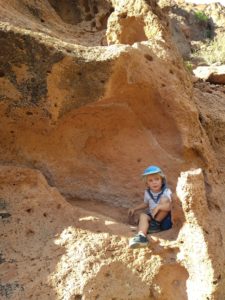
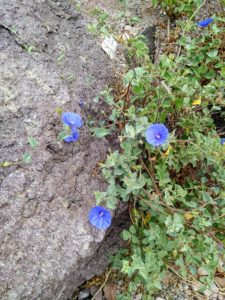
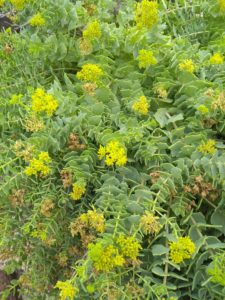
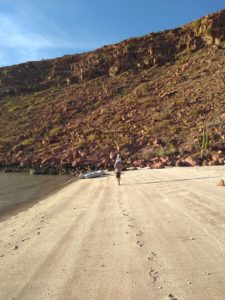 Thanks for reading! I am usually more up-to-date on Instagram, Facebook, and Twitter – when we have phone signal. Blog posts happen now and again, when I can get the rare mixture of time to sit at the computer AND internet! We try to update our location on Farkwar too. If you know the area and have recommendations, let us know, and if you´re nearby, let´s meet up!
Thanks for reading! I am usually more up-to-date on Instagram, Facebook, and Twitter – when we have phone signal. Blog posts happen now and again, when I can get the rare mixture of time to sit at the computer AND internet! We try to update our location on Farkwar too. If you know the area and have recommendations, let us know, and if you´re nearby, let´s meet up!
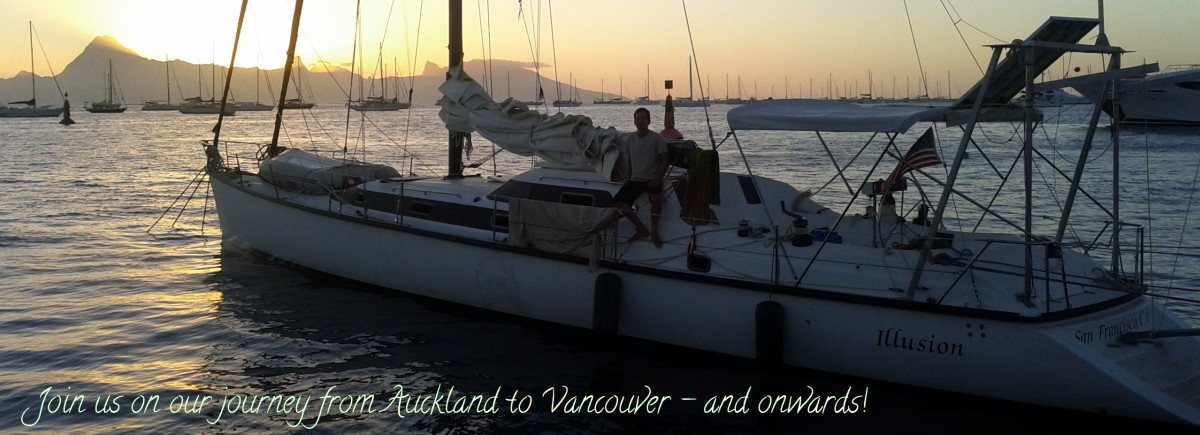
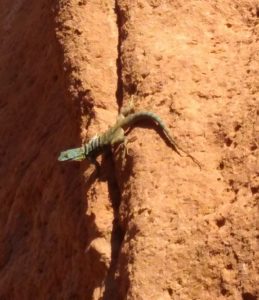
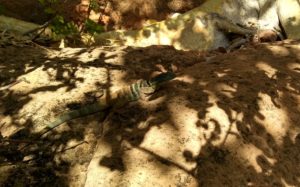
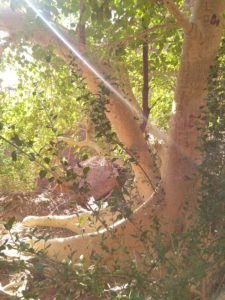
Thank you for another lovely informative post, Sarah. We have had a little too much water here, but my favorite commodity these days as a retiree is time. Time to really read and savour your post and the gorgeous pictures of beautiful sights. May soft winds fill your sails, Anne
Thank you so much Anne! I really appreciate that! Hugs x